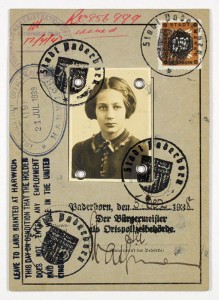75 years ago today, on 2 December 1938, the first of the Kindertransport rescue missions arrived in England. Beatrice Steinberg (née Beate Rose), a benefactor of the Jewish Museum Berlin, was among the last of the Jewish children to be saved in this way, by mass evacuation from Nazi-occupied territories. In her memoirs, which are held in our archives, she recalls her departure from Germany in the summer of 1939:
“My mother took me to the train, which turned out to be one of the last Kindertransporte to England […]. I was so excited that I rushed up the station steps without even saying goodbye to my mother. She called me back. We gave each other a hug and a kiss, then I boarded the train. I stood at the window and we waved goodbye. That was the last time I ever saw her.”

Beate Rose’s number tag from the “Kindertransport” rescue mission
© Jewish Museum Berlin, donated by Beatrice Steinberg
For Beatrice, only twelve years old at the time, the trip was an adventure; for her parents, the decision to let her go off alone, into the unknown, must have been made in great despair. The mass evacuation of children was launched three weeks after the November pogrom. Beate’s father was a prisoner in Buchenwald concentration camp at the time. Like hundreds of thousands of Jewish men and women, her parents hoped to leave Germany as soon as possible. But which country would open its borders to the mass of refugees? Visa restrictions and a bewildering amount of red tape made emigration a protracted and arduous undertaking.
Great Britain and several other European countries, such as the Netherlands, France, Belgium, and Sweden, finally agreed to admit a limited number of children. Transports left Germany, Austria, and Czechoslovakia regularly, up to the beginning of World War II. A speedy departure of the whole family being hopeless, parents tried to get at least their children out of harm’s way.
Beatrice Steinberg donated the documents relating to her Kindertransport to the Jewish Museum Berlin several years ago. Among them is her passport, issued on 5 December 1938. Presumably her parents intended to send her off on a transport as soon as possible. As can be seen from the passport, which is marked with a large “J,” she reached England on 21 July 1939. On a slip attached to the passport is noted the date on which she left her home, the fact that the Relief Association of Jews in Germany organized the transport, and Beate’s registration number in the association’s lists.
We frequently deal with Kindertransports in the framework of our archive’s educational program. Schoolchildren and students explore the topic independently by researching original documents, such as those of Beatrice Steinberg, and learn in this way about the faces and fates behind abstract statistics. In addition, we invite contemporary witnesses, benefactors and friends of the museum, to share their life stories with program participants—for this personal dimension enriches that which the young people learn from archival sources.

Kurt Treitel’s name tag from the “Kindertransport” rescue mission
© Jewish Museum Berlin, donated by Kurt Treitel
Kurt Treitel, who donated a seemingly nondescript paper sign bearing his name, is one of the benefactors involved with the museum. Like all children on the transports, he arrived in England with a tag around his neck, bearing the word “Israel” next to his name, to mark him as a Jew. He was 17 at the time, older than most of the evacuated children. That he was given a place on the train was due to the fact that his uncle already lived in England and could vouch for him.
Only a few stories of this sort are documented in our archives. Kindertransporte to the UK alone saved 10,000 young people in total. The majority never saw their parents again. The “children,” as they call themselves, began meeting regularly in the 1980s, at so-called “reunions,” and their mutual support is a surrogate for the families they lost. A meeting was held in England this year, too, and attended by some “children” of a very ripe old age—75 years after the first transports left Germany.
Franziska Bogdanov, Archive


i would like to find out about the family of my grandmother, who was born in Berkin. my mother uncle who sent to England by KInder transport.
to whom i should write?
thank you.
orit